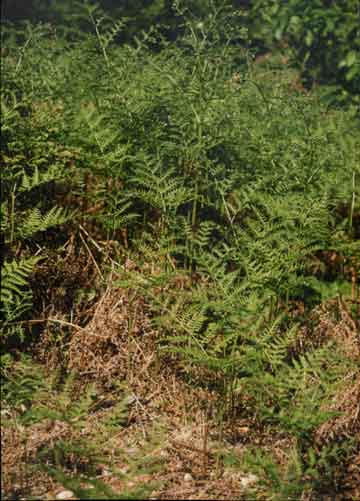
Standard English Name(s):
Bracken Fern
Local English Name(s):
Scientific Name(s): Pteridium aquilinum (L.) Kuhn
Upriver Halkomelem Name(s):
Downriver Halkomelem Name(s):
ptekwum![]()
Island Halkomelem Name(s): suqe:n
~ thuqe:n ![]()
Description, Habitat, Ecology, & Distribution:
This is the world's most widespread fern,
and is found throughout the province from lowlands to montane regions.
It is found in a variety of habitats from open areas to forests, along
the shores of lakes and bogs, and elsewhere.. It is notable for having
large, solitary leaves (fronds) that emanate from specialized stems
called rhizomes that lie deep within the soil.
Upriver Halkomelem Cultural
Role(s):
The young shoots, or "fiddleheads,"
were boiled or steamed in the spring and eaten. The underground stems
were roasted in coals then peeled and eaten (except for the core). They
are best dug in the fall.
Downriver Halkomelem
Cultural Role(s):
The underground stems were eaten.
The fronds were used for wiping up when butchering and when cleaning
old wooden dishes.
Island Halkomelem Cultural
Role(s):
The fresh leaves have been used for wiping
the slime from salmon and as an undermat when cleaning fish. The thick,
underground, root-like stems have been used for food.
CAUTION: This species may be harmful. It produces toxic or otherwise harmful substances, apparently throughout the plant. Human consumption of bracken fern may cause health problems.